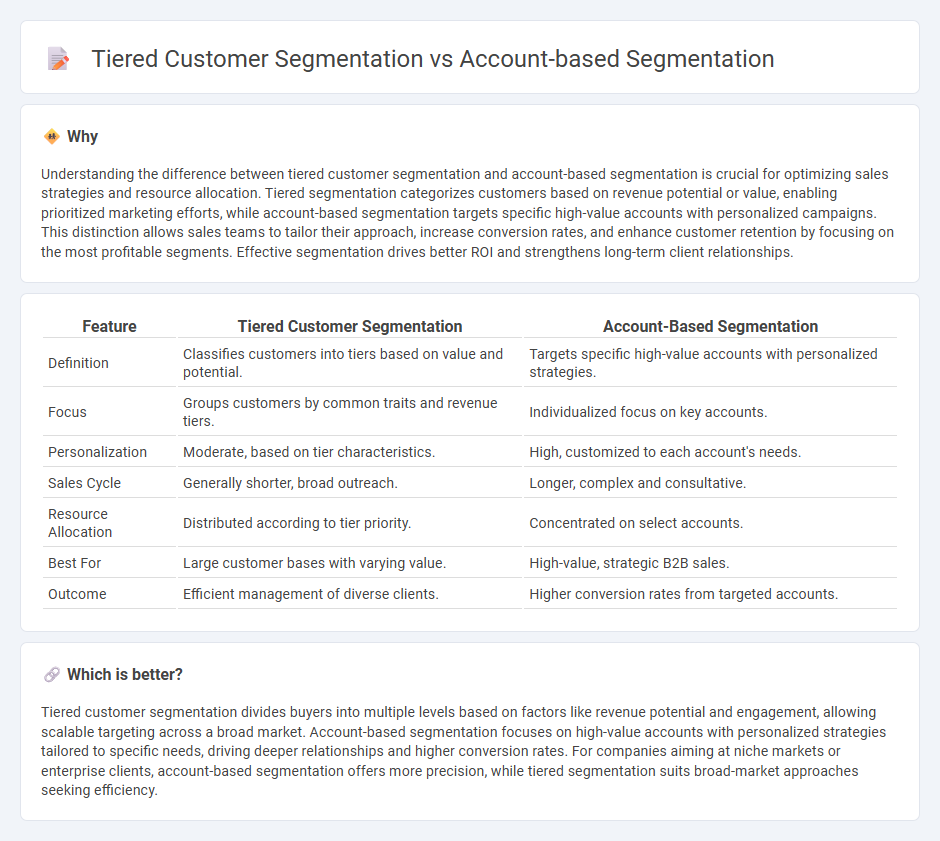
Tiered customer segmentation categorizes clients based on factors like revenue potential, purchase frequency, and engagement levels, enabling tailored sales strategies for varying customer values. Account-based segmentation focuses on identifying and targeting high-value accounts with personalized campaigns and dedicated resources to maximize deal sizes and retention. Explore detailed strategies to optimize sales performance through precise segmentation.
Why it is important
Understanding the difference between tiered customer segmentation and account-based segmentation is crucial for optimizing sales strategies and resource allocation. Tiered segmentation categorizes customers based on revenue potential or value, enabling prioritized marketing efforts, while account-based segmentation targets specific high-value accounts with personalized campaigns. This distinction allows sales teams to tailor their approach, increase conversion rates, and enhance customer retention by focusing on the most profitable segments. Effective segmentation drives better ROI and strengthens long-term client relationships.
Comparison Table
| Feature | Tiered Customer Segmentation | Account-Based Segmentation |
|---|---|---|
| Definition | Classifies customers into tiers based on value and potential. | Targets specific high-value accounts with personalized strategies. |
| Focus | Groups customers by common traits and revenue tiers. | Individualized focus on key accounts. |
| Personalization | Moderate, based on tier characteristics. | High, customized to each account's needs. |
| Sales Cycle | Generally shorter, broad outreach. | Longer, complex and consultative. |
| Resource Allocation | Distributed according to tier priority. | Concentrated on select accounts. |
| Best For | Large customer bases with varying value. | High-value, strategic B2B sales. |
| Outcome | Efficient management of diverse clients. | Higher conversion rates from targeted accounts. |
Which is better?
Tiered customer segmentation divides buyers into multiple levels based on factors like revenue potential and engagement, allowing scalable targeting across a broad market. Account-based segmentation focuses on high-value accounts with personalized strategies tailored to specific needs, driving deeper relationships and higher conversion rates. For companies aiming at niche markets or enterprise clients, account-based segmentation offers more precision, while tiered segmentation suits broad-market approaches seeking efficiency.
Connection
Tiered customer segmentation and account-based segmentation are interconnected strategies that enable businesses to tailor their sales approaches based on customer value and specific account characteristics. Tiered segmentation categorizes customers into different levels such as high, medium, and low value, providing a framework to allocate resources effectively. Account-based segmentation focuses on customizing sales tactics for individual high-value accounts within these tiers, optimizing engagement and increasing conversion rates.
Key Terms
Personalization
Account-based segmentation targets specific high-value clients by tailoring marketing strategies based on detailed company profiles and purchasing behaviors. Tiered customer segmentation groups clients into levels or tiers according to their overall value or engagement, allowing personalized communication that aligns with each tier's distinct characteristics. Explore more to understand how these segmentation methods enhance personalized marketing strategies.
Segmentation Criteria
Account-based segmentation targets specific accounts by aligning marketing efforts with company attributes such as industry, firm size, and revenue. Tiered customer segmentation categorizes clients based on value, engagement level, and potential profitability to prioritize resource allocation effectively. Explore how these segmentation criteria impact personalized marketing strategies and business growth.
Resource Allocation
Account-based segmentation targets key accounts by prioritizing high-value customers and customizing marketing efforts to maximize return on investment, leading to precise resource allocation. Tiered customer segmentation categorizes clients into different levels based on overall value or potential, allowing for scalable allocation of resources across a broader customer base. Explore more to understand which strategy aligns best with your business goals and optimizes resource efficiency.
Source and External Links
ABM Segmentation: How to Build An ROI-Focused ABM Campaign - Account-based marketing segmentation involves dividing your target account list into groups that share similar challenges, goals, and pain points to guide content strategy and improve resource allocation.
The complete guide to account-based marketing segmentation - Segmentation enables hyper-personalized campaigns by grouping accounts with shared characteristics, allowing for targeted messaging that increases engagement and ROI while optimizing resource use.
Account Audiences | Adobe Experience Platform - Account audiences use account profile data to create segments for targeting people within specific accounts across downstream marketing services, distinct from people-based or prospect-based audiences.
 dowidth.com
dowidth.com